I'm trying to build an LSTM network to classify sentences and provide explanation for the classification using saliency. This network must learn from the true class y_true as well as from which words he shouldn't pay attention Z (binary mask).
This paper inspired us to come up with our loss function. Here's what I'd like my loss function to look like :
Coût de classification translates to classification_loss and Coût d'explication (saillance) to saliency_loss (which is the same as gradient of output wrt the input) in the code below. I tried to implement this with a custom Model in Keras, with Tensorflow as backend :
loss_tracker = metrics.Mean(name="loss")
classification_loss_tracker = metrics.Mean(name="classification_loss")
saliency_loss_tracker = metrics.Mean(name="saliency_loss")
accuracy_tracker = metrics.CategoricalAccuracy(name="accuracy")
class CustomSequentialModel(Sequential):
def _train_test_step(self, data, training):
# Unpack the data
X = data[0]["X"]
Z = data[0]["Z"] # binary mask (1 for important words)
y_true = data[1]
# gradient tape requires "float32" instead of "int32"
# X.shape = (None, MAX_SEQUENCE_LENGTH, EMBEDDING_DIM)
X = tf.cast(X, tf.float32)
# Persitent=True because we call the `gradient` more than once
with GradientTape(persistent=True) as tape:
# The tape will record everything that happens to X
# for automatic differentiation later on (used to compute saliency)
tape.watch(X)
# Forward pass
y_pred = self(X, training=training)
# (1) Compute the classification_loss
classification_loss = K.mean(
categorical_crossentropy(y_true, y_pred)
)
# (2) Compute the saliency loss
# (2.1) Compute the gradient of output wrt the maximum probability
log_prediction_proba = K.log(K.max(y_pred))
# (2.2) Compute the gradient of the output wrt the input
# saliency.shape is (None, MAX_SEQUENCE_LENGTH, None)
# why isn't it (None, MAX_SEQUENCE_LENGTH, EMBEDDING_DIM) ?!
saliency = tape.gradient(log_prediction_proba, X)
# (2.3) Sum along the embedding dimension
saliency = K.sum(saliency, axis=2)
# (2.4) Sum with the binary mask
saliency_loss = K.sum(K.square(saliency)*(1-Z))
# => ValueError: No gradients provided for any variable
loss = classification_loss + saliency_loss
trainable_vars = self.trainable_variables
# ValueError caused by the '+ saliency_loss'
gradients = tape.gradient(loss, trainable_vars)
del tape # garbage collection
if training:
# Update weights
self.optimizer.apply_gradients(zip(gradients, trainable_vars))
# Update metrics
saliency_loss_tracker.update_state(saliency_loss)
classification_loss_tracker.update_state(classification_loss)
loss_tracker.update_state(loss)
accuracy_tracker.update_state(y_true, y_pred)
# Return a dict mapping metric names to current value
return {m.name: m.result() for m in self.metrics}
def train_step(self, data):
return self._train_test_step(data, True)
def test_step(self, data):
return self._train_test_step(data, False)
@property
def metrics(self):
return [
loss_tracker,
classification_loss_tracker,
saliency_loss_tracker,
accuracy_tracker
]
I manage to compute classification_loss as well as saliency_loss and I get a scalar value. However, this works : tape.gradient(classification_loss, trainable_vars) but this doesn't tape.gradient(classification_loss + saliency_loss, trainable_vars) and throws ValueError: No gradients provided for any variable.
